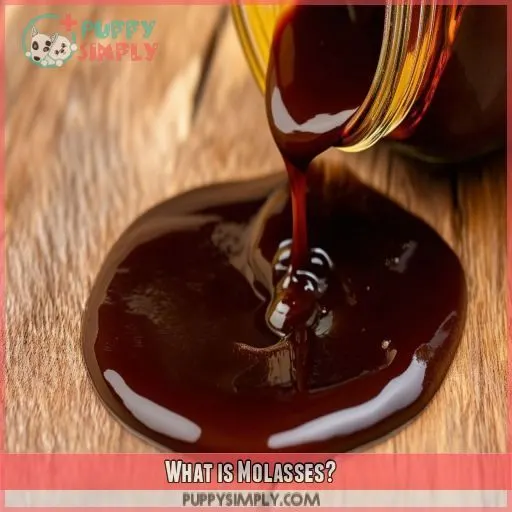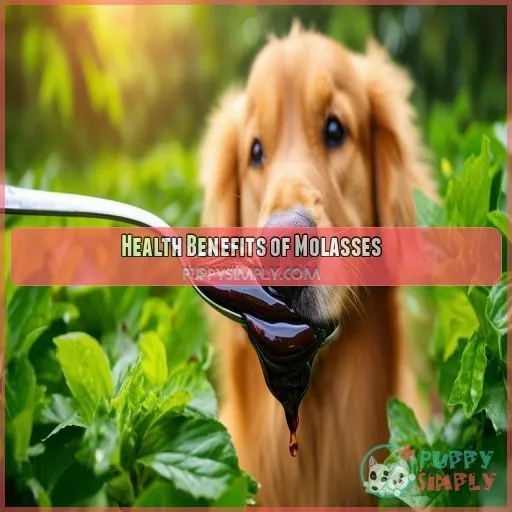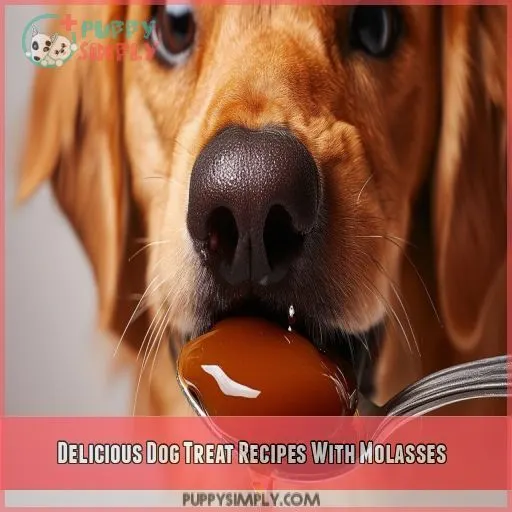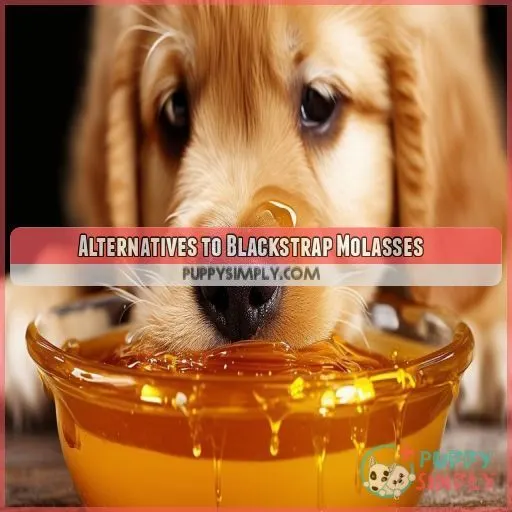This site is supported by our readers. We may earn a commission, at no cost to you, if you purchase through links.
 Dogs can eat molasses, but there are a few things to keep in mind.
Dogs can eat molasses, but there are a few things to keep in mind.
You’ll want to choose the right type of molasses and feed it in moderation.
There are potential health benefits, but also some risks to watch out for.
You’ll also want to make sure to prepare or buy dog treats with molasses safely.
If you want to know more, keep reading.
Table Of Contents
- Key Takeaways
- What is Molasses?
- Health Benefits of Molasses
- How to Feed Molasses to Your Dog
- Delicious Dog Treat Recipes With Molasses
- Cane Molasses in Pet Food
- Shopping for Blackstrap Molasses
- Alternatives to Blackstrap Molasses
- Important Considerations
- Frequently Asked Questions (FAQs)
- Is molasses toxic to dogs?
- Why do dog treats have molasses?
- How do you give a dog molasses?
- What is a good substitute for molasses for dogs?
- How much molasses is too much for my dog?
- Whats the difference between cane molasses and regular molasses?
- Is molasses bad for my dogs teeth?
- Can I use molasses as a sugar substitute in dog treats?
- Can I give my dog molasses every day?
- Conclusion
Key Takeaways
- Molasses is safe for dogs, but it’s important to choose the right type and feed it in moderation. Blackstrap molasses is the best option due to its lower sugar content and higher nutritional value.
- It offers several health benefits for dogs, including improved digestion, bone health, and healthier hair and skin. It may even help prevent type 2 diabetes due to its low sugar content.
- When feeding molasses to your dog, stick to the general rule of thumb: 1 teaspoon per 10 pounds of body weight. Always supervise and consult your vet if any stomach issues arise.
- Raw honey is a great natural substitute for molasses, offering similar benefits and additional nutrients that can help with allergies and stomach woes.
What is Molasses?
So, what’s the deal with molasses? It’s a sweet, sticky syrup that’s left over after sugar is extracted from sugarcane or sugar beets. Think of it like the darker, more intense cousin of maple syrup.
Definition of Molasses
You might be wondering, "What even is molasses?" Well, it’s a natural sweetener made from sugar cane or sugar beets. It’s the thick, dark syrup that’s left over after sugar is extracted. Think of it like the tasty leftovers from making sugar!
But here’s the catch: pure molasses is high in sugar and not ideal for dogs. So, how do we make it dog-friendly? By boiling it multiple times to reduce that sugar content.
Types of Molasses
Molasses comes in several varieties, each with its unique characteristics and benefits. Here’s a quick rundown:
- Light Molasses: The first boiling results in a milder flavor and higher sugar content.
- Dark Molasses: A second boiling reduces the sugar content and increases the nutritional value.
- Blackstrap Molasses: The third boiling produces the lowest sugar and highest nutritional content, making it the healthiest option for dogs.
- Unsulphured Molasses: Free from added sulfur, making it a safer choice for dogs.
- Sulphured Molasses: Contains added sulfur as a preservative, which can be harmful to dogs.
How Molasses is Made
So, how does molasses go from a sweet cane plant to a sticky syrup?
Well, it’s all about the boiling process.
First, sugar cane or sugar beets are crushed to extract their juice.
Then, the juice is boiled to form a thick syrup.
This syrup is then boiled again, and the sugar crystals are extracted, leaving behind that familiar dark liquid we call molasses.
Light Molasses
Light molasses is the result of the first boiling of the sugar syrup. It has a milder flavor but a higher sugar content, which means it’s not the best option for your furry friend.
Dark Molasses
Dark molasses is produced during the second boiling of sugarcane or sugar beet juice. This process further reduces the sugar content, making it slightly healthier than light molasses. Here are some key points about dark molasses:
- Lower Sugar, More Nutritious: Dark molasses has a lower sugar content than light molasses, making it a slightly better option for your dog’s treats.
- Nutritional Value: While it has a reduced sugar content, dark molasses still contains some essential vitamins and minerals, although not as many as blackstrap molasses.
- Safe Dosage: Remember, moderation is key. Stick to the recommended dosage to avoid any digestive issues.
- Not the Healthiest Option: While dark molasses is an improvement over light molasses, it doesn’t offer the same health benefits as blackstrap molasses, which is the healthiest choice.
Blackstrap Molasses
Now we’re getting to the good stuff. Blackstrap molasses is the result of the third boiling of the sugar syrup. This means it has the lowest sugar content and the highest nutritional value, making it the healthiest option for your dog. It’s packed with vitamins and minerals, and its low sugar content may even help prevent type 2 diabetes.
| Type of Molasses | Boiling | Sugar Content | Nutritional Value |
|---|---|---|---|
| Light | First | High | Mild |
| Dark | Second | Medium | Moderate |
| Blackstrap | Third | Low | High |
| Unsulphured | N/A | N/A | N/A |
Unsulphured Molasses
When shopping for molasses, opt for unsulphured varieties. Unsulphured molasses is free of added sulfur, making it a safer choice for your furry friend. Sulfur is used as a preservative, and while it may extend the shelf life of the product, it’s not something you want to feed your pup.
Always read the labels and go for pure, organic options.
Sulphured Molasses
Sulphured molasses is a type to avoid. It contains added sulfur, which is used as a preservative and can be harmful to dogs. Always opt for unsulphured molasses to keep your furry friend safe.
Health Benefits of Molasses
Molasses isn’t just a tasty treat for your pup, it also packs a nutritional punch. Blackstrap molasses, in particular, is a powerhouse of vitamins and minerals, offering health benefits that range from improved digestion to shinier coats.
Rich in Iron, Folate, and B Vitamins
Blackstrap molasses is a powerhouse of nutrients, offering a trifecta of health benefits for your furry friend:
- Iron: This mineral is essential for your dog’s overall health, keeping their energy levels up by helping to produce red blood cells.
- Folate: Also known as vitamin B9, folate is vital for cell growth and a healthy nervous system.
- B Vitamins: These vitamins are key players in maintaining your dog’s metabolism and energy levels, as well as promoting healthy skin and a shiny coat.
Supports Digestion and Bone Health
Blackstrap molasses is a boon for your dog’s digestive and bone health.
It’s especially beneficial for senior dogs, aiding digestion and potentially reducing joint issues like arthritis and osteoporosis.
The calcium and potassium in molasses contribute to strong bones, while the complex carbohydrates provide a steady energy source without spiking blood sugar.
A teaspoon per 10 pounds of body weight is the recommended amount.
Promotes Healthy Hair and Skin
Molasses is a sweet treat that can give your dog’s hair and skin a boost.
The vitamins and minerals in molasses promote healthy hair growth and a shiny coat.
May Help Prevent Type 2 Diabetes
Believe it or not, molasses might actually help prevent type 2 diabetes in dogs. This is due to its low sugar content compared to other sweeteners. It’s a healthier option than artificial sweeteners, which can be dangerous for dogs. So, if you’re looking to satisfy your pup’s sweet tooth while keeping their health in check, molasses could be a great choice.
How to Feed Molasses to Your Dog
So, you want to give your furry friend a tasty treat, but you’re not sure how to go about it. Well, worry not! We’re here to help you understand molasses and share some tips on how to safely feed this sweet treat to your dog.
Moderation is Key
Now that you know about the health benefits of molasses, let’s talk about how much of this sweet treat is safe for your pup. Moderation is key when feeding molasses to your dog. The general rule of thumb is to limit it to 1 teaspoon per 10 pounds of your dog’s body weight. So, if your furry friend weighs 30 pounds, you can offer them up to 3 teaspoons of molasses as an occasional treat.
It’s important to remember that molasses is still a form of sugar, so too much of it can lead to weight gain and other health issues. Always supervise your dog when giving them new treats, and if you notice any signs of stomach upset, such as diarrhea or vomiting, stop feeding molasses and consult your veterinarian.
Choosing the Right Type of Molasses
When choosing the right type of molasses for your dog, go for blackstrap molasses. It has the lowest sugar content and the highest nutritional value, making it the healthiest option for your furry friend. Unsulphured molasses is also a good choice as it doesn’t contain added sulfur, which can be unsafe for dogs.
Preparing Homemade Dog Treats With Molasses
- 4 tablespoons blackstrap molasses
- 1 cup water
- 1 1/2 cups old-fashioned oats
- 1 1/2 teaspoons brewer’s yeast
- 1/2 cup peanut butter
- 6 tablespoons coconut oil
- 2 cups whole wheat flour
Instructions:
- Preheat your oven to 350°F.
- Mix together the molasses, water, coconut oil, and peanut butter until well combined.
- Add the remaining ingredients and mix thoroughly.
- Roll out the dough to a 1/2-inch thickness and cut into fun shapes using cookie cutters.
- Bake for 25-30 minutes, or until the treats are firm.
- Allow the treats to cool completely before storing them in an airtight container.
Your dog will thank you for these tasty and nutritious treats!
Monitoring for Digestive Distress
Molasses can be a great treat for your dog.
However, it’s important to keep an eye out for any digestive distress.
Monitor your dog’s reaction after introducing molasses to their diet.
If they experience diarrhea, vomiting, or any other stomach issues, stop feeding them molasses and consult your veterinarian.
It’s always better to be safe than sorry when it comes to your furry friend’s health.
Delicious Dog Treat Recipes With Molasses
Now that you know all about the benefits of molasses for dogs, it’s time to get cooking! In this section, we’ll share some delicious and healthy dog treat recipes that your furry friend will go crazy for. These recipes are tasty and packed with nutrients to keep your dog happy and healthy.
Sweet Potato Crunch Dog Treats
For a tasty and nutritious treat, try making sweet potato crunch dog treats. This recipe combines mashed sweet potatoes, steel-cut oats, and blackstrap molasses. Simply bake at 200°F for six to eight hours until crispy. Your dog will go crazy for these crunchy, sweet treats!
Coconut Oil and Molasses Dog Treats
If you’re looking for a tasty treat to spoil your furry friend, try whipping up some coconut oil and molasses dog treats. This recipe combines the sweetness of molasses with the health benefits of coconut oil, resulting in a delicious and nutritious snack for your pup. Here’s a simple recipe to get you started:
Ingredients:
- 4 tablespoons blackstrap molasses
- 1 cup water
- 1/2 cup peanut butter
- 6 tablespoons coconut oil
- 1 1/2 cups steel-cut oats
- 2 cups whole wheat flour
- 1 1/2 teaspoons brewer’s yeast
Instructions:
- Preheat your oven to 350°F.
- Mix together the molasses, water, coconut oil, and peanut butter until well combined.
- Add the remaining ingredients and mix thoroughly.
- Roll out the dough to a 1/2-inch thickness and cut into fun shapes using cookie cutters.
- Bake for 25-30 minutes, or until the treats are firm and slightly crispy.
- Let them cool completely before storing them in an airtight container.
Tips for Storing Homemade Dog Treats
Storing your homemade dog treats is easy. Keep them in an airtight container in the fridge for up to three weeks. If you want to keep them longer, pop them in the freezer. They’ll last for months and your pup will still go mutts over them.
Cane Molasses in Pet Food
You might be surprised to find cane molasses in your pet’s food. This dark, viscous liquid is more than just a sweetener. It has a surprising range of benefits for your furry friend.
Nutrient Profile of Cane Molasses
Cane molasses is a source of potassium, iron, and B vitamins, including pyridoxine (B6). These nutrients support healthy blood pressure, bone health, and nutrient metabolism. It also contains antioxidants, which protect your dog’s body from oxidative stress and reduce the risk of associated diseases.
Why Cane Molasses is Used in Pet Food
Cane molasses is used in pet food for three key reasons:
- It acts as a binding agent, giving structure to high-fiber pet food and preventing crumbling.
- It enhances the taste of fiber-rich food, making it more appealing to pets.
- It’s a natural, plant-based ingredient with nutritional benefits, including potassium, iron, and B vitamins.
Simple Vs. Complex Carbohydrates
Carbs are like fuel for your pup’s body.
Simple carbs, like table sugar, are like a shot of espresso—a quick burst of energy.
Complex carbs, on the other hand, are more like a slow-burning log in a fireplace, providing sustained energy.
Cane molasses is a complex carb, so it won’t send your dog’s blood sugar spiking.
In fact, studies show that a little molasses in your dog’s diet can be good for their cholesterol levels.
Shopping for Blackstrap Molasses
When shopping for blackstrap molasses, look for organic and unsulphured options. Avoid products with added sulfur or artificial sweeteners, as these can be harmful to dogs.
Look for Organic and Unsulphured Options
When shopping for blackstrap molasses, keep these three things in mind:
- Opt for organic: Choose organic molasses to make sure it’s free from pesticides and other chemicals.
- Unsulphured is best: Unsulphured molasses hasn’t been treated with sulfur, making it a safer option for your furry friend.
- Check the ingredients: Always read the label to make sure there are no added sugars, artificial sweeteners, or other harmful ingredients.
Alternatives to Blackstrap Molasses
While blackstrap molasses is a healthy option for your dog, you might be wondering if there are any alternatives. Raw honey is a great substitute, offering similar benefits and a host of nutrients that can help with allergies and stomach upsets.
Raw Honey as a Natural Sweetener
If you’re looking for a natural sweetener to replace blackstrap molasses, raw honey is a great option. It’s an unpasteurized sweet treat with potential benefits for your dog’s allergies and stomach woes.
| Sweetener | Benefits |
|---|---|
| Raw Honey | Natural remedy for allergies and stomach upset |
| A quarter teaspoon per 20 lbs of body weight is enough |
Blackstrap molasses is packed with more vitamins and minerals, but raw honey still offers a nutritious boost. So, if you’re concerned about your dog’s sugar intake, raw honey is a safer bet.
Other Natural Sweeteners for Dogs
While blackstrap molasses is a safe option for your pup, you might be wondering about other natural sweeteners. Here’s a lowdown on some alternatives:
- Honey – A small amount of raw honey can offer potential benefits for allergies and stomach issues.
- Maple syrup – This treat is high in minerals. Go for pure maple syrup and use it sparingly.
- Agave nectar – With a lower glycemic index, agave nectar is a good option for diabetic dogs, but it’s still high in fructose.
- Fruit – Fresh fruit like apples and berries can satisfy your dog’s sweet tooth while providing vitamins.
Important Considerations
Feeding your furry friend can be tricky, so it’s always smart to be cautious. Before introducing new foods like molasses, a quick chat with your veterinarian is a smart move. They can guide you on any potential risks and give the green light if all’s good to go.
Consult With Your Veterinarian
Before feeding your dog molasses or any new food, it’s important to talk to your veterinarian. They can give you personalized advice and make sure it’s safe for your dog’s unique needs.
| Question to Ask Your Vet | Example Scenario | Why It Matters |
|---|---|---|
| Are there any potential risks or side effects? | "My dog has a sensitive stomach. Could molasses cause digestive issues?" | Your vet can assess your dog’s health and identify potential risks, especially if they’ve underlying conditions. |
| How much molasses is safe to feed my dog? | "I’m unsure how much molasses to add to my dog’s diet." | Vets can guide you on safe amounts, considering your dog’s weight, age, and overall health. |
| Does molasses interact with my dog’s medications? | "My dog is on daily supplements. Will molasses affect their absorption?" | Molasses may impact the effectiveness of certain medications, so it’s important to check for potential interactions. |
| What’re signs of an allergic reaction? | "What should I watch out for in case my dog has an allergy?" | Your vet can explain specific symptoms to monitor, making sure you’re prepared. |
| Are there any long-term health concerns? | "Could feeding molasses regularly impact my dog’s long-term health?" | Vets can advise on potential long-term effects, offering guidance for your dog’s diet. |
Monitor for Allergic Reactions
While molasses is generally safe for dogs, keep an eye out for any allergic reactions. Here’s what to watch for:
- Itchy skin: If your dog starts scratching excessively, it could be a sign of an allergic reaction.
- Digestive issues: Vomiting, diarrhea, or a decrease in appetite could indicate an intolerance to molasses.
- Respiratory problems: Coughing, sneezing, or difficulty breathing could be a sign of a more severe allergic reaction.
If you notice any of these symptoms, stop feeding your dog molasses and consult your veterinarian. It’s better to be safe than sorry!
Learn More About Pet Nutrition
It’s always good to learn more about pet nutrition.
This empowers you to make informed decisions about your furry friend’s diet.
Check out resources from trusted pet food brands, which often offer educational content on pet nutrition.
They can provide personalized advice and help you navigate the often-confusing world of pet food and supplements.
Frequently Asked Questions (FAQs)
Is molasses toxic to dogs?
A stitch in time saves nine." Molasses isn’t toxic to dogs, but some sweeteners are. Xylitol, for example, is deadly to dogs. So, check the ingredients and only give your dog natural, organic molasses in small amounts.
Why do dog treats have molasses?
Molasses is added to dog treats as a sweetener, binder, and preservative. It’s also a good source of vitamins and minerals. However, it’s high in sugar, so it should only be given to dogs in moderation.
How do you give a dog molasses?
You can give your dog molasses as a treat, but only in moderation. Choose blackstrap molasses, and limit it to 1 teaspoon per 10 pounds of your dog’s body weight.
What is a good substitute for molasses for dogs?
Raw honey is a good substitute for molasses. It’s loaded with nutrients and has added benefits for allergies and stomach issues. A quarter teaspoon per 20 lbs of body weight is enough.
How much molasses is too much for my dog?
Too much molasses can cause dental damage, stomach problems, obesity, and diabetes in dogs. Limit treats to a teaspoon per 10 pounds of body weight.
Whats the difference between cane molasses and regular molasses?
Cane molasses is made from sugar cane juice, boiled down to create a syrup. Regular molasses is a byproduct of the sugar-making process, left behind after sugar crystals are extracted from sugar cane or sugar beets.
Is molasses bad for my dogs teeth?
Yes, light-coloured molasses is high in sugar and can be bad for your dog’s teeth. It’s especially harmful to diabetic dogs.
Can I use molasses as a sugar substitute in dog treats?
Want to sweeten up your pup’s treats without the sugar rush? You can use molasses as a sugar substitute in dog treats, but go easy on it—it’s still sweet stuff. Blackstrap molasses is a good choice, with less sugar and more nutrients.
Can I give my dog molasses every day?
Yes, you can give your dog a small amount of molasses daily. Opt for blackstrap molasses, which has the lowest sugar content and the highest nutritional value.
Conclusion
So, can dogs eat molasses? Absolutely!
From choosing the right type of molasses to feeding it in moderation, you now have the sweet scoop on how to safely include this ingredient in your dog’s diet.
With a bit of caution and some tasty recipes, your furry friend can enjoy the benefits of molasses without any risks.
Go ahead and give them a delicious treat that’s both nutritious and safe.














